#ccdn331.p2
Text
Critical Perspective - CCDN331 P2
Haiku:
“Looking up above
Seeing the evolving now
Understanding change”
Relph explains that the idea of a “city” has changed drastically in the past 140 years. Today’s society is more about getting from a to b without understanding the elements of one’s surrounding. In the past people were more observant and patient to comprehend a “slower moving” city environment, whereas now it is more of an “urban jungle” and often a hectic mess of industry to be consumed in.
My aim was to create a blend between the old and new structures of wellington CBD, in tail this showed the contrast of the city and how it is constantly updating. It also helped me as a “Flâneur” to comprehend my surroundings in ways which I had not previously understood. Through using the process of a flâneur, the idea of my “Critical Selfie” changed from attempting to create a blend between old and new, to more of an understanding of what was already present in the wellington skyline and how these new modern high-rise buildings impose upon the more classical structures throughout the city. I experienced this contrast by simply “looking up above” as the Haiku states. Through using these ideas as a flâneur, it is clear that the relation of these classic buildings in the city lined up along Lambton Quay beside the high-rises is a battle for attention and an ever growing contrast.
Citation:
Relph, E. (1987). The Modern Urban Landscape, 1-274. Retrieved from https://books.google.co.nz/books?hl=en&lr=&id=cWLtWKEnq3EC&oi=fnd&pg=PP9&dq=neo+classical+vs+modernist+cityscape&ots=0-l-7mA2_D&sig=qgSuenLDHjaX8EVP5fs5rJ9uJ3I#v=onepage&q&f=false
0 notes
Video
vimeo
CCDN331 Project 2 Final Photo Essay
In my final project I explored the personification of the flaneur, a person separate from the rules governing a city. I imagined colourful, simplified humanoid creatures who roam the transitory, “inbetween” places. These creatures have a naïve yet slightly ominous air, as a being who uses often unfriendly places as their home, undisturbed by the graffiti of human presence.
Photos of their habitat are overlaid with each other, creating blended generalisations of these places. My original attempt at the simplification of these transitory places was entirely compositional, but it did not communicate my true intention, nor did it show my voice. I feel that this final blending of spaces instead generalises the “inbetween” conceptually, rather than visually. Indeed, this method of simplification was in my very first reading on the flaneur. Certeau explores the representation of the city as a panorama, a totalisation of the complex “immense texturology” which separates the viewer from the everyday workings of the city (2009, p. 247).
These concepts of a flaneur-like creature separated from a concept-city was furthermore enhanced in my choice of soundtrack. I used the sounds created by installation piece “Wall Street Sound Machine”, an instrument that produces such different sounds to its original purpose in life. I then combined this with the waterphone, an eerie and unusual instrument that highlights the sometimes threatening nature of the dark alleyway. The characters in these photos have a great freedom, but they also live on the outskirts of society – and they are not entirely friendly.
Certeau, M. (2009). Walking In The City. In Brody, D., Design Studies: A Reader. Oxford: Berg.
0 notes
Photo

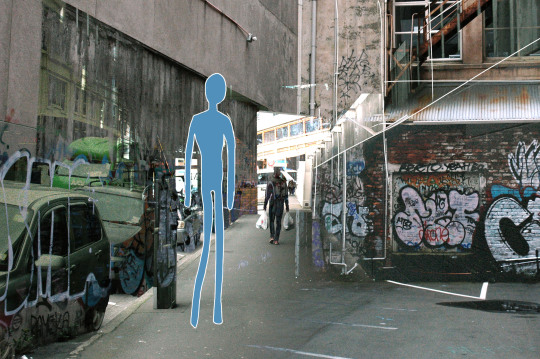
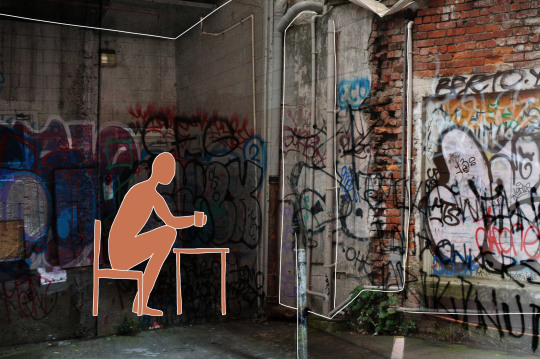
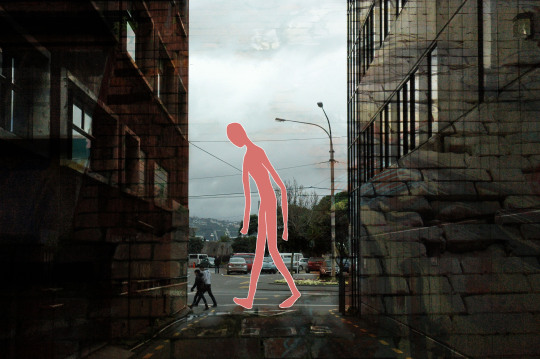
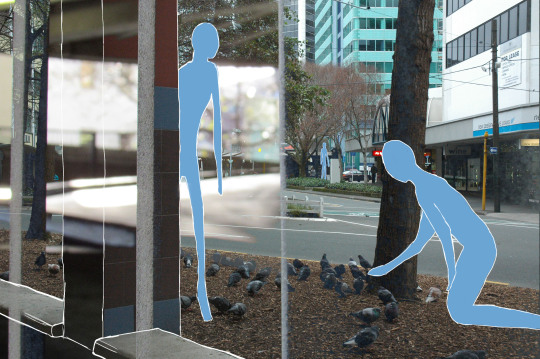
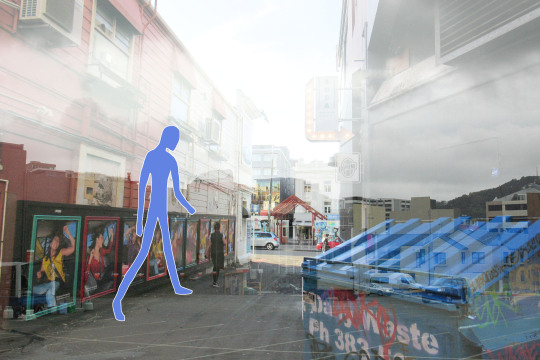
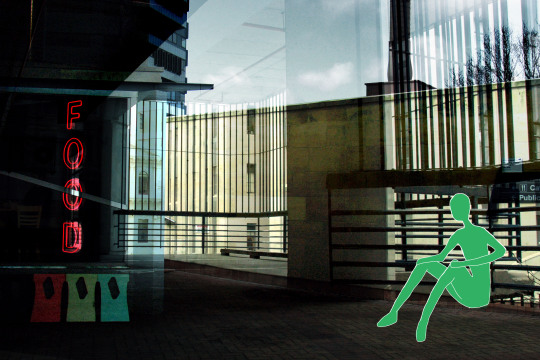

CCDN331 Project 2 Final Images
My final images for the video. Everything started to work when I started overlaying photos, making “inbetweens of the inbetween”. I had experimented with this technique in my first year photographics paper but this time I wanted to see how I could make locations seem real but also slightly seperated and not quite-there, a lot like the characters in the photos.
I’m considering adding a texture to the colour of the people so they don’t seem so simple. However keeping them simple also increases the contrast in how separate they are.
1 note
·
View note
Photo
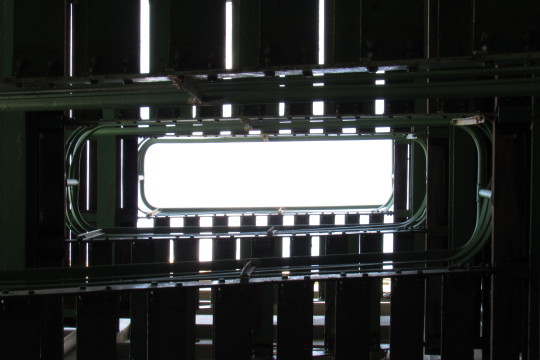
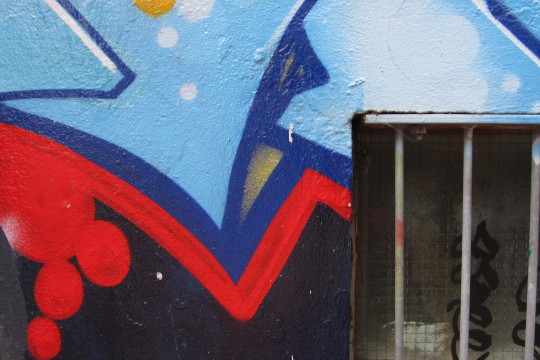



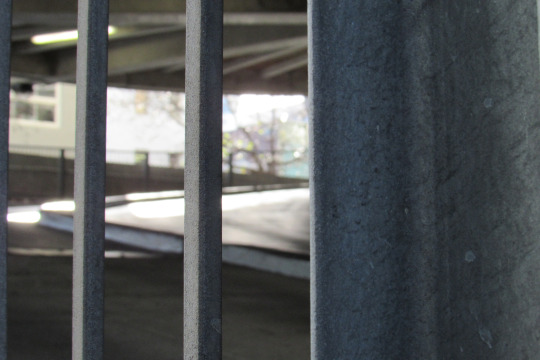

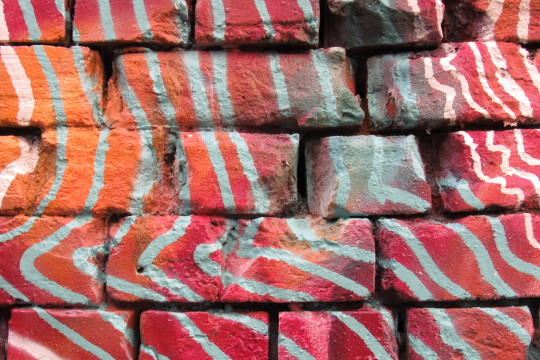
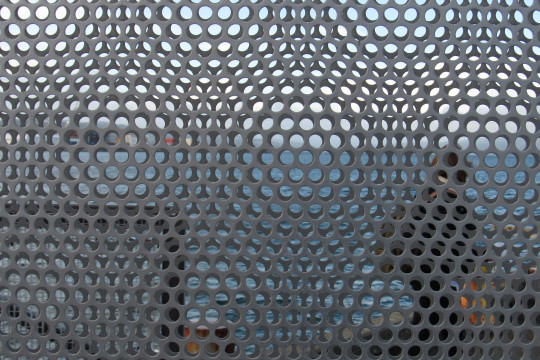
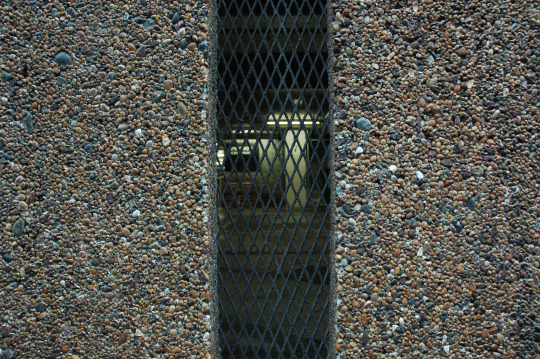
CCDN331 Project 2 favourite “Simplifying the inbetween” photos
1 note
·
View note
Photo







CCDN331 Project 2 More Photos - “Invisible figures” idea
A few more examples for the invisible figures idea, sketched out roughly. The finished photos would include a rough style of line-art and some of the colour would be more cohesive.
1 note
·
View note
Text
CCDN331 Project 2 Sound Research
While searching for some kind of example of the sound I’d like to create, I got distracted and came across this really interesting website about sound art.
In particular, I really liked the music in this interview and the sounds created by this installation piece called the Wall Street Sound Machine, pictured below.
1 note
·
View note
Photo








CCDN331 Further Exploration
More photos from my second shoot. It’s interesting how different things look when I photograph them on a cloudy day. I was thinking it might make everything flatter (and therefore simpler) but it also gives less contrast to things so they blend together and become more complex.
2 notes
·
View notes
Photo






CCDN331 Further Exploration
I also continued to develop the idea from my initial photos - this idea of simplifying the “inbetween” places.
2 notes
·
View notes
Photo



CCDN331 Project 2 Further Exploration
I had this idea in my head that I had to try out to see what it would be like. While walking through the city, looking through the viewfinder of my camera, I thought it would be interesting trying to express the manifestation of this “being” or presence completely separated from everything else, like the flaneur. A bit creepy and oversized, like imprints from other worlds.
2 notes
·
View notes
Photo







CCDN331 Project 2 Initial Photos 3
1 note
·
View note
Photo







CCDN331 Project 2 Initial Photos 2
1 note
·
View note
Photo






CCDN331 Project 2 Initial Photos 1
1 note
·
View note
Text
CCDN 331 Project 2: Critical Perspective
After learning about the Flaneur and Gamification in the first two lectures of this course, I felt compelled to explore the city in the photo essay through a set of rules that I prescribed myself. A point in Certeau’s chapter, “Walking in the City” expressed the idea of decay in the city, something I feel can very prevalent in Central Wellington. The “Pervasive Games” reading was also strangely in tune with ideas Certeau expressed.
I decided to challenge myself to find these complex public counter-spaces and simplify them, bringing them closer to the preferred “format” of an ideal city.
“but the city is left prey to contradictory movements that counterbalance and combine themselves outside of the reach of panopric power... the Concept-city is decaying”
Certeau, M. (2009). Walking In The City. Design Studies: A Reader. Brody, D. Oxford: Berg, 2009. 249. Print.
“The constant drive to renegotiate the accepted uses of public space is a struggle to wrestle the defining power from the hegemony to the countercultural movements.“
Stenros, J., Montola, M., Mayra, F. (2007). Pervasive Games in Ludic Society. Future Play '07 Proceedings of the 2007 conference on Future Play. 30-37.
0 notes






